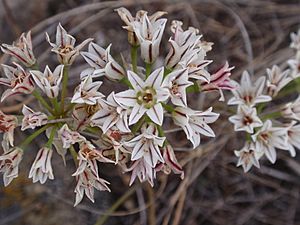Pitted onion facts for kids
Quick facts for kids Pitted onion |
|
|---|---|
 |
|
| var. lacunosum | |
| Scientific classification |
Allium lacunosum is a type of wild onion often called the pitted onion. This plant is special because it grows only in California. You can find it in many different places there, from areas near the bay to mountains and even deserts. It's a common and important part of California's plant life.
What Does the Pitted Onion Look Like?
The pitted onion, known scientifically as Allium lacunosum, starts its life from a bulb. This bulb is usually yellowish-brown and has a thick outer layer. It's about one or two centimeters long, which is roughly the size of a small grape.
The plant's stem can grow quite tall, reaching up to about 35 centimeters (about 14 inches). This means it can be as tall as a school ruler and a bit more! It usually has two leaves. These leaves can be as long as, or even longer than, the stem itself.
Its Flowers
At the top of the stem, you'll find a cluster of small flowers. This cluster is called an inflorescence. It can hold up to 45 tiny flowers! Each flower is less than a centimeter long, so they are quite small. They are usually white or a pale pink color, and you might notice dark veins on their petals.
Different Kinds of Pitted Onion
Just like there are different breeds of dogs, there are different types, or varieties, of the pitted onion. There are four known varieties of Allium lacunosum. Three of these are not very common, making them a bit special to find.
- Allium lacunosum var. davisiae — This variety is found in Southern California.
- Allium lacunosum var. kernense — You can find this one in the southern Sierra Nevada mountains and the Mojave Desert.
- Allium lacunosum var. lacunosum — This is the most common variety.
- Allium lacunosum var. micranthum — This variety grows in the inland mountain ranges of the Central Coast of California.
See also
 In Spanish: Allium lacunosum para niños
In Spanish: Allium lacunosum para niños

